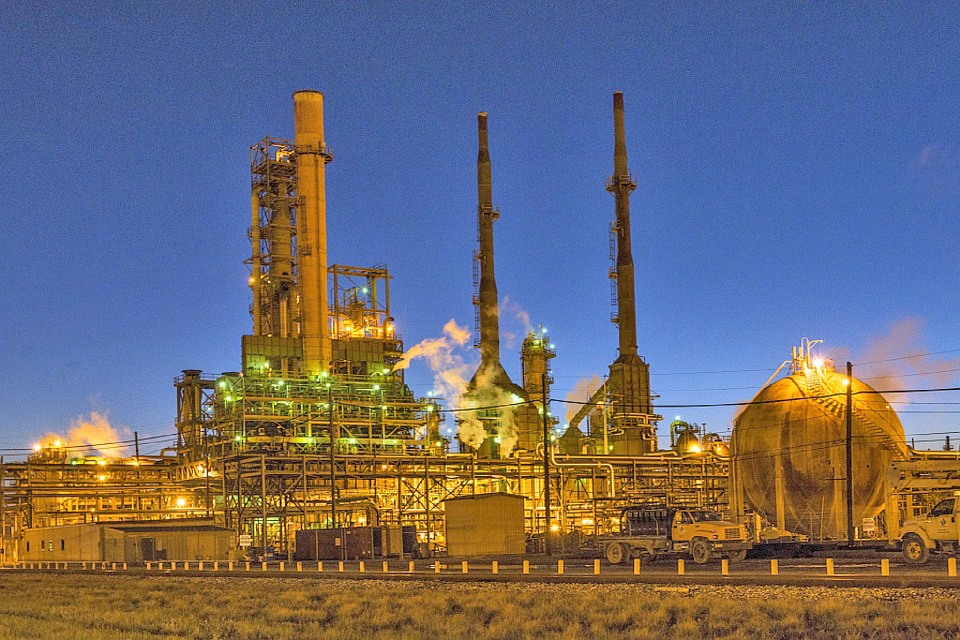The fall of the oil boom, the rise of petrochemicals in Texas
The discovery of oil in Texas dates back much further, but the first economically significant discovery came in 1894 in Navarro County near Corsicana. According to the Texas State Historical Association, the Corsicana oilfield developed gradually and peaked in 1900, when it produced more than 839,000 barrels of oil. The first relatively modern refinery in Texas, operated by the J. S. Cullinan Company, opened at the field in 1898. The major importance of the Corsicana field lay in establishing the potential for commercial oil production in Texas. With the construction of a carbon black (a raw material derived from natural gas) plant in Stephens County in 1923, the Texas petrochemical industry was born.
Products derived from oil and natural gas are the backbone of the Texas petrochemical industry, mostly concentrated along the Texas Gulf Coast and in the Permian Basin. The need for synthetic rubber and synthetic chemicals for explosives during World War II prompted the development of the highly specialized petrochemical industry in Texas. After 1952 the state’s share in the American petrochemical industry increased dramatically, and during the 1960s Texas played an increasingly diversified role in all phases of the petrochemical industry: furnishing and processing oil and gas, producing petrochemicals, and manufacturing commercial commodities.

The economic benefits of the chemical and petrochemical industry were vast, but not its environmental problems. By the late 1970s the chemical industry as a whole produced 3.9 million tons of solid waste, ranking Texas sixth in the nation in annual output of chemical waste. In response to environmental concerns, many of the chemical and petrochemical companies joined the Clean Industries 2000, an organization committed to reducing hazardous waste and environmental pollution. By the 1990s Texas led the nation in the production of chemical products including petrochemicals. Then in late 2014, the price of oil tanked, which spelled big trouble for the Houston economy. The petrochemical boom came at just the right time. According to the U.S. Energy Information Administration, Texas accounted for over 27% of U.S. marketed natural gas production in 2015, making it the leading natural gas producer among the states. Texas chemical manufacturers are one of the biggest users of natural gas, which they use to manufacture chemical products – namely polyethylene beads – that are the primary component of plastic products.
Today, natural gas is the raw material used to make 96 percent of the products we use each day like cell phones, laptops, shampoo, eyeglasses and heart valves. Several new petrochemical plants have or will come online this year because of the cheap and ample shale gas supplies that serve as the feedstock for the facilities. The facility, called an ethylene cracker, takes ethane from natural gas production and converts it into ethylene, which is the primary building block for most plastics.
What makes ethylene unique is a part of the molecule called a double bond. That area is very reactive and particularly well-suited for many different chemical reactions, which makes ethylene one of the most important chemicals in all chemistry. The method for producing ethylene depends on high tech engineering and uses a tremendous amount of energy. The common term for this engineering feat is called cracking, because the energy is used to break apart (or crack) molecules and form new molecules, and the petrochemical plant is called a cracker.
The petrochemical sector is expanding nationwide. In a report released in March, the industry trade group American Chemistry Council says there have been more than $161 billion pumped into U.S. chemical projects since 2010. The new projects for chemical and plastic production are forecast to provide a much needed lift to America’s economy by creating an estimated 426,000 new jobs and $301 billion in new economic output. No other U.S. manufacturing sector is on such a pace of expansion.
But transportation may not be keeping pace with the industry. Trucking is the primary transportation mode used by the chemicals industry, representing an estimated 54 percent of overall industry shipments. Due to weight restrictions, Texas manufacturers face challenges getting their products to Texas ports for export. The gross weight limit on Texas highways under current state law is 80,000 pounds, with special permits allowing only limited increases – a restriction that has trucks transporting partially empty containers to Texas ocean-going ports on the Gulf of Mexico. Senate Bill 1524 and House Bill 3854 would increase truck weight within a 30-mile radius of port areas and international border crossings in Texas. proposed legislation aims to increase the current legal weight limit from 80,000 to 100,000 pounds — raising the load by about 10 tons.
The U.S. Department of Transportation stated in a 2016 Final Report to Congress, that heavier trucks have over 47-percent higher crash rates in limited state testing. The report also stated that extending the weight limit would also cause a significant amount of wear-and-tear on many Texas roads. For example, raising weight limits to 91,000 pounds would negatively affect more than 4,800 bridges, incurring up to $1.1 billion of additional federal investment, the report claimed.
Strategic Partnerships, Inc. is your leading source for P3 News. Sign up for our free weekly e-newsletters to ensure you never miss out.

 512-531-3900
512-531-3900 Request More Info
Request More Info